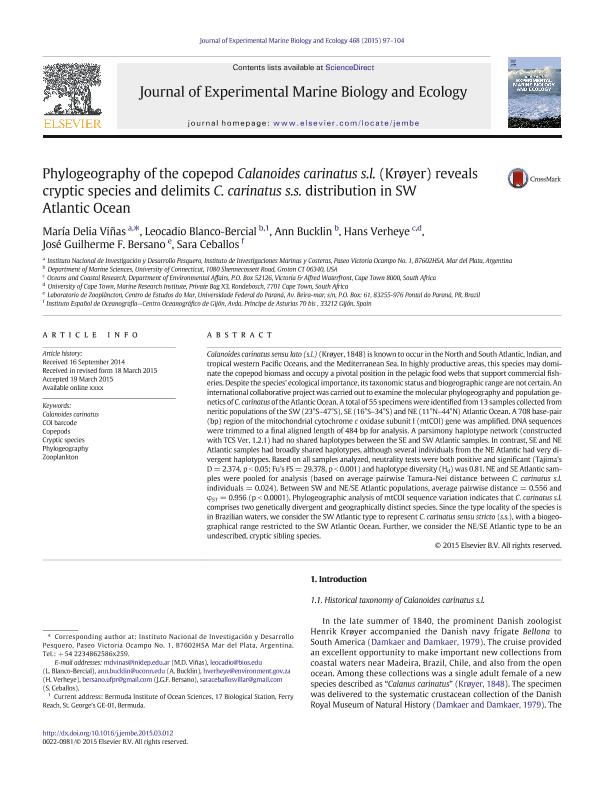Artículo
Phylogeography of the copepod Calanoides carinatus s.l. (Krøyer) reveals cryptic species and delimits C. carinatus s.s. distribution in SW Atlantic Ocean
Viñas, Maria Delia ; Blanco Bercial, Leocadio; Bucklin, Ann; Verheye, Hans; Bersano, José Guilerme F.; Ceballos, Sara
; Blanco Bercial, Leocadio; Bucklin, Ann; Verheye, Hans; Bersano, José Guilerme F.; Ceballos, Sara
 ; Blanco Bercial, Leocadio; Bucklin, Ann; Verheye, Hans; Bersano, José Guilerme F.; Ceballos, Sara
; Blanco Bercial, Leocadio; Bucklin, Ann; Verheye, Hans; Bersano, José Guilerme F.; Ceballos, Sara
Fecha de publicación:
07/2015
Editorial:
Elsevier Science
Revista:
Journal of Experimental Marine Biology and Ecology
ISSN:
0022-0981
Idioma:
Inglés
Tipo de recurso:
Artículo publicado
Clasificación temática:
Resumen
Calanoides carinatus sensu lato (s.l.) (Krøyer, 1848) is known to occur in the North and South Atlantic, Indian, and tropical western Pacific Oceans, and the Mediterranean Sea. In highly productive areas, this species may dominate the copepod biomass and occupy a pivotal position in the pelagic food webs that support commercial fisheries. Despite the species´ ecological importance, its taxonomic status and biogeographic range are not certain. An international collaborative projectwas carried out to examine the molecular phylogeography and population genetics of C. carinatus of the Atlantic Ocean. A total of 55 specimenswere identified from13 samples collected from neritic populations of the SW (23°S?47°S), SE (16°S?34°S) and NE (11°N?44°N) Atlantic Ocean. A 708 base-pair (bp) region of the mitochondrial cytochrome c oxidase subunit I (mtCOI) gene was amplified. DNA sequences were trimmed to a final aligned length of 484 bp for analysis. A parsimony haplotype network (constructed with TCS Ver. 1.2.1) had no shared haplotypes between the SE and SW Atlantic samples. In contrast, SE and NE Atlantic samples had broadly shared haplotypes, although several individuals from the NE Atlantic had very divergent haplotypes. Based on all samples analyzed, neutrality tests were both positive and significant (Tajima´s D=2.374, p b 0.05; Fu´s FS=29.378, p b 0.001) and haplotype diversity (Hd) was 0.81. NE and SE Atlantic samples were pooled for analysis (based on average pairwise Tamura-Nei distance between C. carinatus s.l. individuals = 0.024). Between SW and NE/SE Atlantic populations, average pairwise distance = 0.556 and φST = 0.956 (p b 0.0001). Phylogeographic analysis of mtCOI sequence variation indicates that C. carinatus s.l. comprises two genetically divergent and geographically distinct species. Since the type locality of the species is in Brazilian waters, we consider the SW Atlantic type to represent C. carinatus sensu stricto (s.s.), with a biogeographical range restricted to the SW Atlantic Ocean. Further, we consider the NE/SE Atlantic type to be an undescribed, cryptic sibling species.
Palabras clave:
Calanoides Carinatus
,
Coi Barcode
,
Cryptic Species
,
Phylogeography
,
Zooplankton
Archivos asociados
Licencia
Identificadores
Colecciones
Articulos(CCT - MAR DEL PLATA)
Articulos de CTRO.CIENTIFICO TECNOL.CONICET - MAR DEL PLATA
Articulos de CTRO.CIENTIFICO TECNOL.CONICET - MAR DEL PLATA
Citación
Viñas, Maria Delia; Blanco Bercial, Leocadio; Bucklin, Ann; Verheye, Hans; Bersano, José Guilerme F.; et al.; Phylogeography of the copepod Calanoides carinatus s.l. (Krøyer) reveals cryptic species and delimits C. carinatus s.s. distribution in SW Atlantic Ocean; Elsevier Science; Journal of Experimental Marine Biology and Ecology; 468; 7-2015; 97-104
Compartir
Altmétricas



